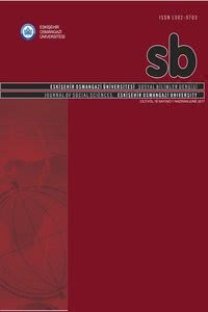Türkiye'de kamu-özel imalat sanayinde ücret ve işgücü verimliliği ilişkisi
Labor productivity and wages relations in the Turkish private-public manufacturing industry
___
- Bozkurt, H. (2007), Zaman Serileri Analizi, 1. Baskı, Ekin Kitabevi, Bursa.
- Christopoulos, K. D. (2005), “A Note on the Relationship Between Real Wages and Employment: Further Evidence from Panel Cointegration Tests”, Journal of Economic Studies, 32(1), ss.25–32.
- Chubrik, A. (2006), “Wage and Labor Productivity in Belarus”, IPM Research Center, (http://research.by/pdf/WP2006e01.pdf).
- Dickey, D. A. ve Fuller, W. A. (1979), “Distribution of the Estimators for an Autoregressive Time Series with a Unit Root”, Journal of American Statistical Association, 74, ss.251-276.
- Duque C. J., Ramos, R. ve Suriñach, J. (2006), “Wages and Productivity: The Role of Labor Market Institutions in OECD Countries”, Empirical, 33, ss.231-243.
- Enders, W. (1995), Applied Econometric Time Series, John Wiley&Sons, New York.
- Eşiyok, B. Ali, (1999), İmalat Sanayinde (Kamu-Özel Sektör Ayrımı Ekseninde Ücret ve Verimlilik Serilerinin İstatistiki ve Ekonometrik Bir Analizi, Türkiye Kalkınma Bankası Araştırma Müdürlüğü, Ankara.
- Hsiao, C. (1979), “Causality Tests in Econometrics”, Journal of Economic Dynamics and Control, 7, ss.326-335.
- Mankiw, G. N. (1990), “A Quick Refresher Course in Macroeconomics, NBER Working Paper Series, no: 3256, ss.1-40.
- Marquetti, A. (2004), “Do Rising Real Wages Increase the Rate of Labor-Saving Technical Change? Some Econometric Evidence, Metroeconomica, 55(4), ss.432-441.
- Millea, M. (2002), “Disentangling the Wage-Productivity Relationship: Evidence from Select OECD Member Countries”, IAER, 8(4), ss. 314-323.
- Narayan, K. P. ve Smyth, R. (2006), “The Effect of Inflation and Real Wages on Productivity: New Evidence from a Panel of G7 Countries”, Discussion Paper: Accounting Finance, and Economics, no :11/06, (http://www.griffith.edu.au/school/gbs/afe/research/vol_01_1106_effect_ of_inflation_and_real_wages_on_productivity.pdf).
- Özmucur, S. (2003), “Wage and Productivity Differentials in Private and Public Manufacturing: The Case of Turkey”, Econ WPA Series, no: 0303002, (http://129.3.20.41/eps/io/papers/0303/0303002.pdf).
- Strauss, J. ve Wohar, M. (2004), “The Linkage Between Prices, Wages and Labour Productivity: A Panel Study of Manufacturing Industries”, Southern Economic Journal, 70, ss.920-941.
- Wakeford J. (2004a), “The Productivity-Wage Relationship in South Africa: an Empirical Investigation”, Development Southern Africa, 21(1), ss.109–132.
- Wakeford J. (2004b), “Productivity, Wages and Employment in South Africa’s Manufacturing Sector, 1970-2002”, Development Policy Research Unit, Working Paper, ss.1-32.
- Yayın Aralığı: 3
- Başlangıç: 2000
- Yayıncı: -
TÜRKİYE’DE KAMU-ÖZEL İMALAT SANAYİNDE ÜCRET VE İŞGÜCÜ VERİMLİLİĞİ İLİŞKİSİ
Salih Türedi ve Harun Terzi, Salih TÜREDİ, Harun TERZİ
Bülent Öz, Sami Taban ve Muhsin Kar, Sami TABAN, Muhsin KAR
Nasreddin Hoca fıkralarında kültürel unsurlar
Küresel enerji politikaları ve Türkiye : Petrol ve doğal gaz kaynakları açısından bir karşılastırma
Türkiye'de kamu-özel imalat sanayinde ücret ve işgücü verimliliği ilişkisi
TÜRKİYE’DE CARRY TRADE YATIRIM STRATEJİSİ VE BELİRLEYİCİLERİ ARASINDAKİ İLİŞKİ: 2001-2007
İlkay Öner Badurlar, İlkay ÖNER BADURLAR
2001 EKONOMİK KRİZİNİN TÜRKİYE SANAYİ SEKTÖRÜ ÜZERİNDEKİ NET KRİZ ETKİSİNİN ANALİZİ
Bahar Berberoğlu, Bahar BERBEROĞLU
Türkiye'de carry trade yatırım stratejisi ve belirleyicileri arasındaki ilişki : 2001-2007
Bülent ÖZ, Muhsin KAR, Sami TABAN
KÜRESEL ENERJİ POLİTİKALARI VE TÜRKİYE: PETROL VE DOĞAL GAZ KAYNAKLARI AÇISINDAN BİR KARŞILAŞTIRMA
